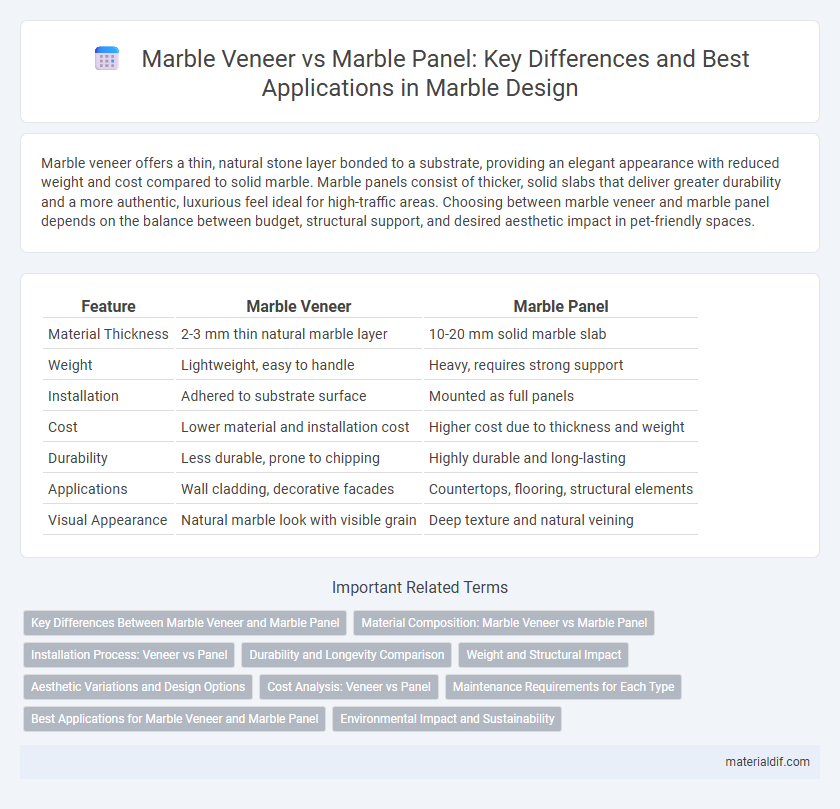Marble veneer offers a thin, natural stone layer bonded to a substrate, providing an elegant appearance with reduced weight and cost compared to solid marble. Marble panels consist of thicker, solid slabs that deliver greater durability and a more authentic, luxurious feel ideal for high-traffic areas. Choosing between marble veneer and marble panel depends on the balance between budget, structural support, and desired aesthetic impact in pet-friendly spaces.
Table of Comparison
| Feature | Marble Veneer | Marble Panel |
|---|---|---|
| Material Thickness | 2-3 mm thin natural marble layer | 10-20 mm solid marble slab |
| Weight | Lightweight, easy to handle | Heavy, requires strong support |
| Installation | Adhered to substrate surface | Mounted as full panels |
| Cost | Lower material and installation cost | Higher cost due to thickness and weight |
| Durability | Less durable, prone to chipping | Highly durable and long-lasting |
| Applications | Wall cladding, decorative facades | Countertops, flooring, structural elements |
| Visual Appearance | Natural marble look with visible grain | Deep texture and natural veining |
Key Differences Between Marble Veneer and Marble Panel
Marble veneer consists of thin slices of natural marble adhered to a substrate, offering aesthetic appeal with reduced weight and cost, whereas marble panels are thicker, solid marble pieces providing greater durability and structural strength. Veneers are ideal for decorative applications like wall cladding and furniture surfaces, while panels are commonly used in flooring, countertops, and architectural installations requiring robust performance. The choice between veneer and panel hinges on factors such as budget, installation complexity, and desired longevity of the marble surface.
Material Composition: Marble Veneer vs Marble Panel
Marble veneer consists of thin slices of natural marble adhered to a substrate, preserving the stone's authentic mineral composition and irregular veining patterns. Marble panels, however, are thicker slabs often composed of engineered stone or composite materials, combining crushed marble with resins for enhanced durability and uniformity. The material composition impacts weight, installation ease, and maintenance, where veneers offer genuine marble aesthetics with reduced thickness, while panels provide structural integrity and consistent surface quality.
Installation Process: Veneer vs Panel
Marble veneer requires a meticulous installation process involving the application of thin marble slices onto a substrate, ensuring a strong adhesive bond and careful handling to prevent cracking due to its thinness. Marble panels, being thicker and more rigid, allow for a more straightforward installation using mechanical fasteners or anchors, providing structural support and durability. The choice between veneer and panel installation affects time, labor intensity, and the stability of the marble surface.
Durability and Longevity Comparison
Marble veneer offers a thinner, more lightweight covering that may be less durable and prone to chipping over time compared to marble panels, which are thicker and provide enhanced structural integrity. Marble panels, often used in high-traffic or exterior applications, demonstrate superior longevity by withstanding weathering, impact, and wear more effectively. Choosing marble panels ensures a longer-lasting finish suitable for both residential and commercial projects where durability is critical.
Weight and Structural Impact
Marble veneer typically weighs between 10 to 15 pounds per square foot, significantly lighter than marble panels, which can weigh 20 to 25 pounds per square foot. This difference in weight directly affects the structural load on buildings, with marble veneer placing less stress on supporting frameworks, making it ideal for retrofitting and lightweight construction. The reduced weight of marble veneer minimizes the need for extensive structural reinforcement compared to heavier marble panels, influencing project budgets and design flexibility.
Aesthetic Variations and Design Options
Marble veneer offers a slim profile that allows for flexible application on curved or intricate surfaces, enhancing design versatility with natural stone aesthetics. Marble panels provide a thicker, solid slab that emphasizes durability and depth of texture but may limit creative installation on complex geometries. Both options showcase unique veining patterns and color variations, with veneers enabling seamless visual flow across large areas and panels highlighting pronounced natural patterns for bold architectural statements.
Cost Analysis: Veneer vs Panel
Marble veneer typically costs less than marble panels due to its thinner profile and lower material usage, making it a budget-friendly option for surface covering. Marble panels, being thicker and more substantial, result in higher transportation and installation expenses, increasing the overall project cost. Evaluating long-term durability and maintenance needs alongside initial costs offers a comprehensive understanding of the economic impact between marble veneer and panel choices.
Maintenance Requirements for Each Type
Marble veneer requires regular sealing and gentle cleaning to prevent staining and damage due to its thin natural stone layer, making maintenance more frequent but manageable with proper care. Marble panels, being thicker and more robust, offer greater durability and resistance to wear, reducing the need for frequent sealing and allowing easier upkeep in high-traffic areas. Both options benefit from avoiding acidic cleaners and abrasive materials to preserve their polished surface and extend their lifespan.
Best Applications for Marble Veneer and Marble Panel
Marble veneer is best suited for interior applications such as wall cladding, backsplashes, and decorative surfaces due to its lightweight nature and ease of installation. Marble panels, being thicker and more robust, are ideal for structural uses like countertops, flooring, and exterior facades where durability and load-bearing capacity are critical. Choosing between marble veneer and marble panels depends on the required strength, installation complexity, and intended design impact in residential or commercial projects.
Environmental Impact and Sustainability
Marble veneer, being a thin, lightweight layer of marble, requires less raw material extraction compared to marble panels, significantly reducing quarrying waste and environmental disruption. Its lower transportation weight decreases carbon emissions, enhancing sustainability in construction projects. Conversely, marble panels, though durable, involve more substantial resource use and energy for production and installation, leading to a higher environmental footprint.
Marble Veneer vs Marble Panel Infographic

 materialdif.com
materialdif.com